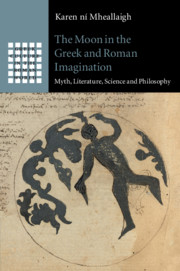Book contents
- The Moon in the Greek and Roman Imagination
- Greek Culture in the Roman World
- The Moon in the Greek and Roman Imagination
- Copyright page
- Dedication
- Contents
- Acknowledgements
- Abbreviations, Text References and Translations
- Part I The Moon in the Mythic Imagination
- Part II The Moon in the Scientific Imagination
- Part III The Moon in the Fantastic Imagination
- Chapter 5 The Imaginary Moon
- Chapter 6 Selēnoskopia
- Envoi
- Bibliography
- Index
- Index Locorum
Chapter 6 - Selēnoskopia
The Moon-View from Fiction to Reality
from Part III - The Moon in the Fantastic Imagination
Published online by Cambridge University Press: 09 October 2020
- The Moon in the Greek and Roman Imagination
- Greek Culture in the Roman World
- The Moon in the Greek and Roman Imagination
- Copyright page
- Dedication
- Contents
- Acknowledgements
- Abbreviations, Text References and Translations
- Part I The Moon in the Mythic Imagination
- Part II The Moon in the Scientific Imagination
- Part III The Moon in the Fantastic Imagination
- Chapter 5 The Imaginary Moon
- Chapter 6 Selēnoskopia
- Envoi
- Bibliography
- Index
- Index Locorum
Summary
In the previous chapter, we explored the semiotics of the lunar world in ancient fictions, especially Lucian’s works. In this chapter, we leave Earth and consider – with ancient thinkers and modern astronauts – what our reality looks like when viewed from the Moon. Selēnoskopia or the ‘view from the Moon’ became a reality for the first time in the first year of the Apollo missions in 1968, but the imaginative tradition of gazing at the Earth from outer space has a far more ancient pedigree, stretching back to the earliest Greek literature over two-and-a-half millennia ago. In Lucian’s hands, the Moon became our first extra-terrestrial viewing-platform and the focus for an extraordinary continuum of thought that links ancient imagined experience with modern reality.
- Type
- Chapter
- Information
- The Moon in the Greek and Roman ImaginationMyth, Literature, Science and Philosophy, pp. 261 - 290Publisher: Cambridge University PressPrint publication year: 2020

